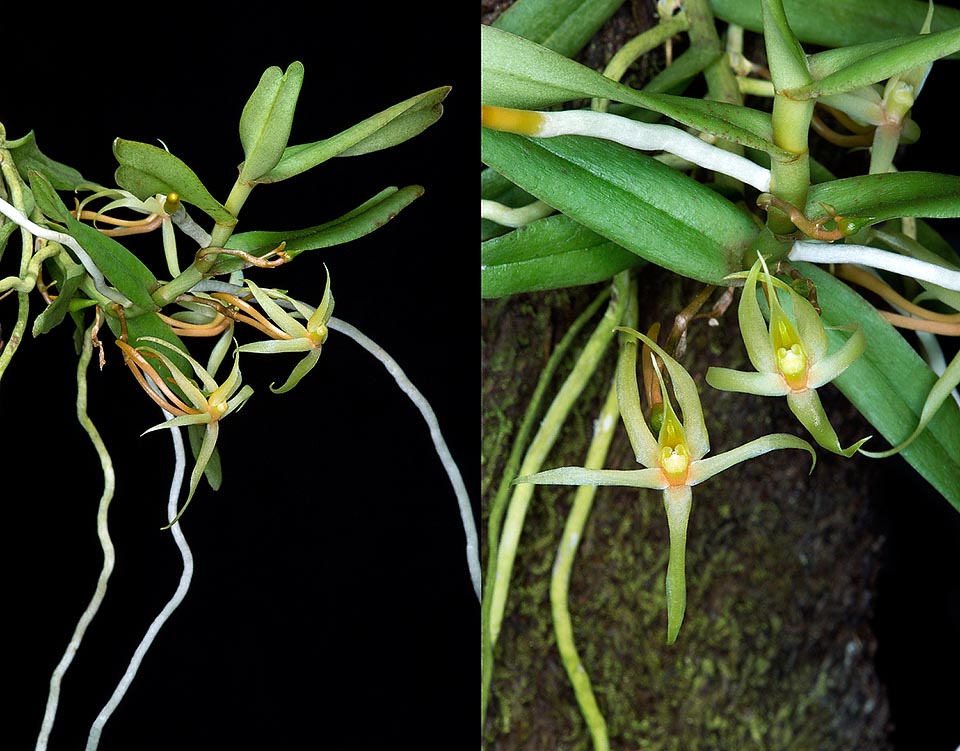Family : Orchidaceae

Text © Pietro Puccio

English translation by Mario Beltramini
The species is native to Tropical Africa (Cameroon, Central African Republic, Congo, Democratic Republic of the Congo, Gabon, Ghana, Guinea, Guinea Gulf Islands, Ivory Coast, Liberia, Nigeria, Rwanda, Togo and Uganda) where it grows as epiphyte on the higher branches of the trees in the dense humid forests, between the 1000 and 2000 m of altitude.
The name of the genus comes from the Malay one, “angurek”, utilized for epiphytic orchids; the specic Latin name “moandense” = of Moanda, refers to the river of the Democratic Republic of the Congo near which has been found the type species.
The Angraecum moandense De Wild. (1916) is an epiphytic species with thin stems, at times ramified, tendentially drooping, 6-15 cm long and of 2-3 mm of diameter, with 0,5-1 cm long internodes and aerial roots along the stem, of about 2 mm of diameter, particularly frail. Alternate leaves, distichous, oblong-linear with curved margins and asymmetrically bilobed apex with obtuse lobes, 2,5-8,5 cm long and 0,5-1 cm broad, coriaceous, of pale green colour, with the foliar sheaths wrapping entirely the stem.
Inflorescences opposite to the leaves, up to 5 cm long, bearing 1-4 flowers not resupinate (with the labellum on top over the column), on an up to about 2 cm long pedicel and ovary, of greenish white to yellowish white colour.

Angraecum moandense is a small epiphyte with thin 6-15 cm stems, often ramified and drooping. Inflorescences up to 5 cm long with 1-4 tiny corollas © Giuseppe Mazza
Almost similar sepals, lanceolate with acuminate apex, 0,8-1,5 cm long and 1,5-3 mm broad, linear-lanceolate petals, 0,9-1,2 cm long and 1-1,2 mm broad, ovate-elliptic labellum with long pointed apex, concave, 0,8-1 cm long and 2-3,5 mm broad, provided at the base of a thin spur, 1,5-2 cm long.
It reproduces by seed, in vitro, by division and through the young plants that get out at the base and along the main stems.
Miniature orchid not infrequently present in the collections of the orchid enthusiasts, requires high luminosity, but not direct sun, intermediate temperatures, 16-30 °C, high humidity, 75-85%, and a light constant ventilation. Waterings and nebulizations regular in the morning, more spaced in the coldest months, but without ever leaving it to dry up completely, utilizing rain water, demineralized or by reverse osmosis at ambient temperature. It is preferably mounted on trunks, bark, rafts of cork or of roots of arborescent ferns with a layer of sphagnum at the base to maintain the humidity. Alternatively, it can be cultivated in suspended baskets with draining and aerated compost made of medium sliced bark fragments. Transplants and possible divisions are to be done when strictly necessary, as it does not love to be frequently disturbed, upon the first signs of vegetative restart.
The species is reported in the appendix II of CITES (species whose trade is ruled at international level).
Synonyms: Aerangis moandensis (De Wild.) Schltr. (1918); Angraecum chevalieri Summerh. (1936); Angraecoides moandensis (De Wild.) E.M.Pessoa & M.Alves (2016).
→ For general notions about ORCHIDACEAE please click here.
